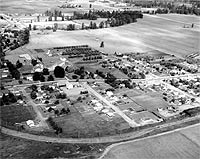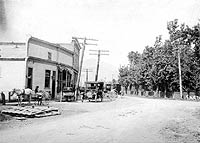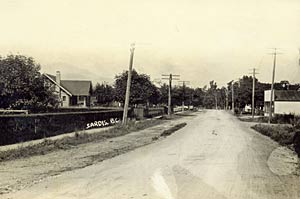
Mrs. Adam Swart Vedder is credited for choosing the name Sardis when she randomly opened her Bible and found the name Sardis in the Book of Revelations, 3, 1.
In 1887, residents of Sardis petitioned the federal government for a post office. In documents supporting the application, E. H. Fletcher, Post Office Inspector for British Columbia, described Sardis; "There is no village properly speaking but the farmers houses are all situated within a reasonable distance of the proposed site….At least thirty families would make use of the office if established, as well as from thirty to forty unmarried settlers residing in the vicinity." (Coutts, Cecil C., Cancelled With Pride, A History of Chilliwack Area Post Offices, 1865-1993, Cecil C. Coutts Publishing. Page 71). Residents got their post office soon after this request.



Henry Hulbert began growing hops on his Vedder Road property about the same time. Hops, a labor intensive industry, remained important to Sardis until 1997 when the last farm ceased production. Both the B.C. Hops Company and the John I. Haas Hop Company became players in the hop industry.
In 1896, A. C. Wells' Edenbank Creamery that had operated for several years was reorganized and became the first co-operative creamery in British Columbia. The Wells' farm continued to prosper during this period.
These developments ensured the success of a viable business center. In 1891, Alex Campbell built the first store. Campbell's business included dry goods and groceries and he accepted farm produce in exchange for goods. In succeeding years the store was owned by Joseph Ogle, John Henry Ashwell, Alan Langstaff and the Ernie and Clifford Pearson. Other businesses followed and located to the strategic intersection of Vedder and Knight Roads.
In 1910, construction of the British Columbia Electric Railway through Sardis added to the community's growth. Electricity, water and phone service arrived with the railway. Subdivisions began to appear. In 1910, one-acre lots were advertised for $500 and these values were expected to go up.
Carman Methodist Church opened in 1898 followed by St. John's Anglican Church in 1912.
Reminders of this earlier period can still be found in Sardis. The Coqualeetza Director's House (1896), the A.C. Wells retirement home (1897), the Edenbank Trading Company store (1907) and the Horatio Webb retirement home (1911) act as sentinels to the period when Sardis was a village community.